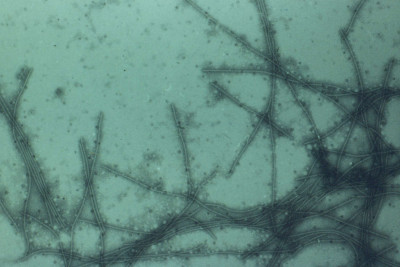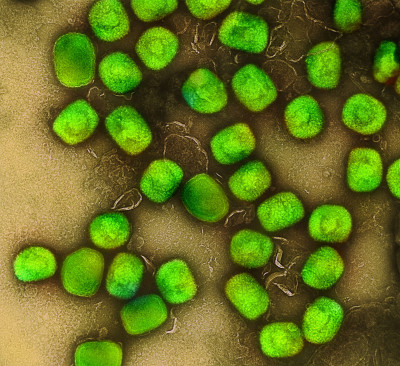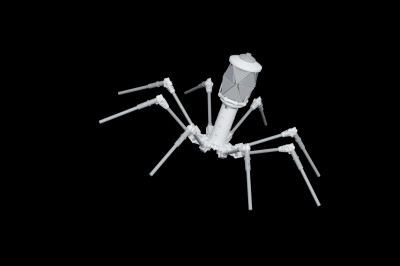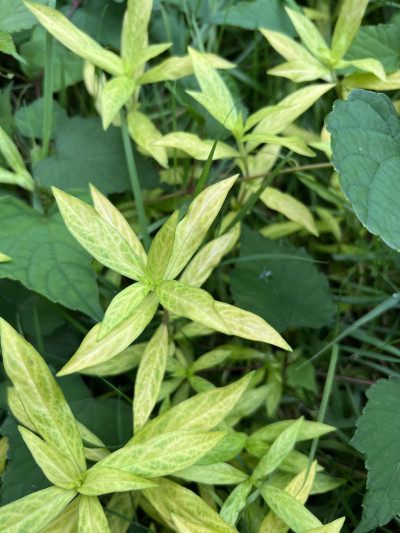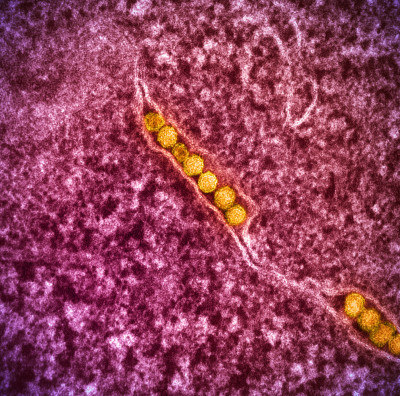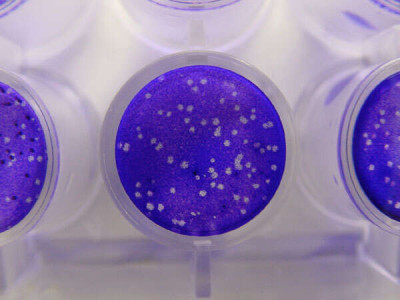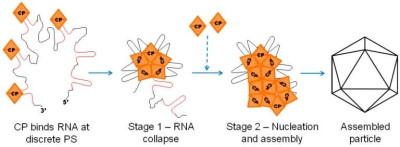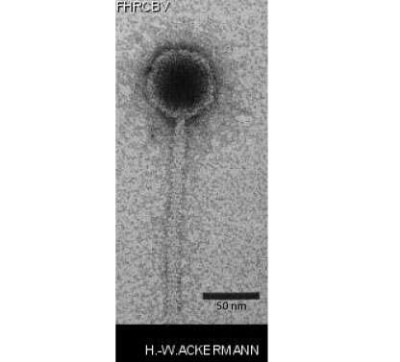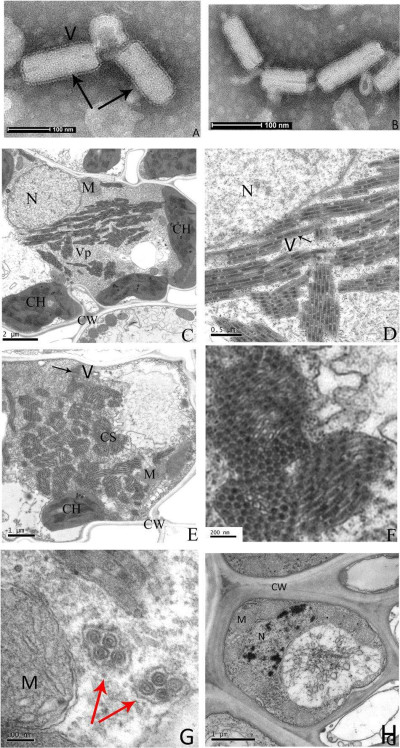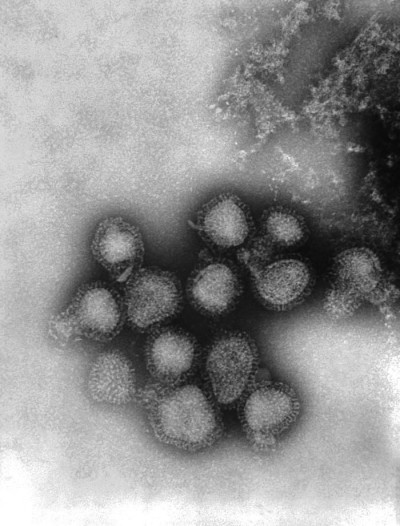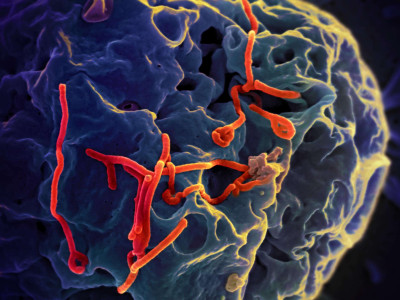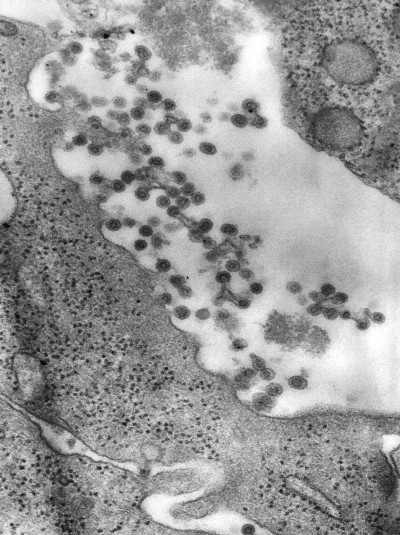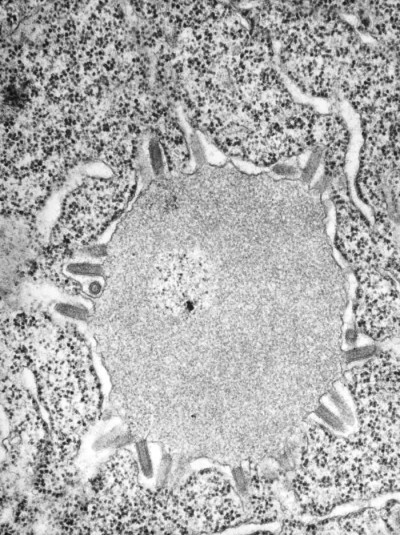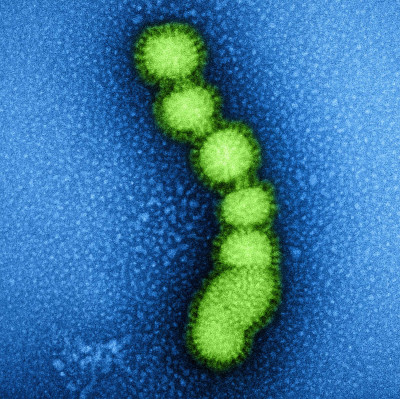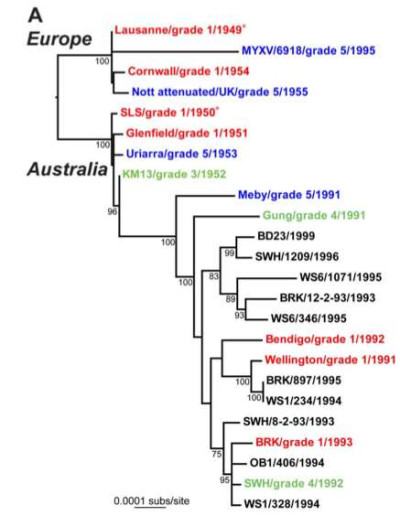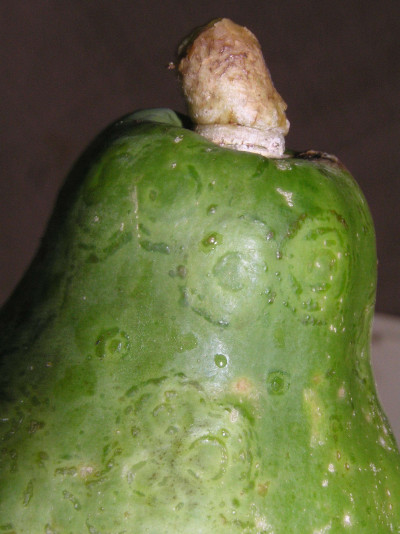Transmission electron micrograph of Papaya ringspot virus (PRSV) particles.
Wikimedia Commons
07 Apr 2024
Colorized transmission electron micrograph of monkeypox virus particles (green) cultivated and purified from cell culture. Image captured at the NIAID Integrated Research Facility (IRF) in Fort Detrick, Maryland.
Wikimedia Commons, NAID
07 Apr 2024
My previous phage was a bit of a free build from memory, this one tries to stay a little closer to the real thing.
Wikimedia Commons, Pascal
10 Apr 2024
Diodia vein chlorosis virus (DVCV) is a plant virus that primarily affects Diodia species, particularly Diodia teres, also known as poorjoe, a weed commonly found in tropical and subtropical regions. Infected plants typically exhibit symptoms such as chlorotic or yellowing veins on the leaves, leaf mottling or stippling, and general stunting of growth. The severity of symptoms can vary depending on factors such as the viral strain, host plant species, and environmental conditions.
iNaturalist
11 May 2024
PRSV-infected (right), transgenic and disease-free (left) papaya (Carica papaya).
Wikimedia Commons, Stephen Ferreira, Plant pests and diseases
15 Mar 2024
Putative tail structure (arrowed) can be observed in Emiliania huxleyi virus 86 (EhV-86) in the cytoplasm of infected Emiliania huxleyi before release of progeny virions.
Wikimedia Commons, Wilson, W.H., Van Etten, J.L., Schroeder, D.C., Nagasaki, K., Brussaard, C., Bratbak, G. and Suttle, C.; Mackinder et al.
25 Jan 2024
Transmission electron micrograph of West Nile virus particles (gold) replicating within the cytoplasm of an infected VERO E6 cell (pink). Image captured at the NIAID Integrated Research Facility (IRF) in Fort Detrick, Maryland.
NIAID, Wikimedia Commons
08 Feb 2024
Macroscopic photograph of viral plaque formation. Vero cells, which grew confluently on the bottom of the plastic plate (1.5 cm diameter), were infected with herpès simplex virus (approximately 75 plaque forming unit), and then cultured over night to make viral plaque. Living cells were stained with crystal violet. The viral plaques, each was from one virion, remained transparent.
Y tambe, Wikimedia Commons
22 Feb 2024
Illustration of the two stage viral capsid assembly for an alpha virus. The red sections are packaging signals on the RNA genome. These serve to correctly assemble the capsid proteins. [1]
Adriano Mendes and Richard J. Kuhn, Wikimedia Commons
22 Feb 2024
EM image of a virion of the genus Tunavirus (formerly Tunalikevirus).
ViralZone, SIB Swiss Institute of Bioinformatics, Wikimedia Commons
01 Mar 2024
Electron micrograph of infected rice leaves. Negative-stained sap of infected rice leaves (A,B). Ultrathin sections of infected rice leaves showing RSMV virions and cytopathological structures (C–G), the enlarged CS of (E) is shown in (F). The uninfected rice leaves cells are shown in (H). Black arrows indicate the RSMV virions with enveloped, red arrows indicate the vesicle structure with gathered virions in it. CW = cell wall, CH = chloroplast, CS = crystalline structure, M = mitochondrion, N = nucleus, V = Virion, and Vp = viroplasm.
Wikimedia Commons, Xin Yang, Jilei Huang, Chuanhe Liu, Biao Chen, Tong Zhang, and Guohui Zhou
02 Apr 2024
This negatively-stained transmission electron micrograph (TEM) revealed the presence of a number of Hong Kong flu virus virions, the H3N2 subtype of the influenza A virus. This virus is a Orthomyxoviridae virus family member, and was responsible for the flu pandemic of 1968-1969, which infected an estimated 50,000,000 people in the United States, killing 33,000. Note the proteinaceous coat, or capsid, surroundind each virion, and the hemagglutinin-neuraminidase spikes, which differ in terms of their molecular make-up from strain to strain.
Public Health Image Library
02 Apr 2024
Scanning electron micrograph of Ebola virus budding from the surface of a Vero cell (African green monkey kidney epithelial cell line.
Wikimedia Commons, NAID
03 Apr 2024
This negatively-stained transmission electron micrograph (TEM) revealed the presence of Rubella virus virions, as they were in the process of budding from the host cell surface to be freed into the host’s system, thereby, producing an enveloped virus particle, which means that after budding, the spherical virions' icosahedral capsid is enclosed in the host cell membrane. Inside the capsid lies the Rubella virus’ positive-sense single-stranded RNA ((+)ssRNA) genome. The Rubella virus is known to be the cause of rubella, otherwise known as German measles.
Wikimedia Commons
07 Apr 2024
The passive layer, correlating with the improved corrosion resistance appears enriched in nitrogen solute species and acts as an inhibitor for the growth of GRI+II in DCT samples and subsequently magnetite (Fig a,d). This phenomenon (DCT-induced passive layer) has been observed for the first time, correlating DCTs with the corrosion properties of high-alloy iron alloys. In addition to this layer, the specific development of a superimposed oxide layer (partly part of the passive film) is also observed, where the first inner layer is determined to be magnetite and then the outer layer is composed of other oxide/hydroxide species that are also present in the CHT sample. Furthermore, a slight depletion of alloying elements is observed for the DCT sample, which is explained by the protective barrier formed by the passive film as shown [1].
12 Jan 2024
This transmission electron micrograph (TEM) depicted a highly magnified view of a tissue that had been infected with Rift Valley fever (RVF) virus. RVF virus is a member of the genus Phlebovirus in the family Bunyaviridae and was first reported in livestock in Kenya around 1900. It is found to be an acute, fever-causing viral disease that affects domestic animals (such as cattle, buffalo, sheep, goats, and camels) and humans. RVF is most commonly associated with mosquito-borne epidemics during years of unusually heavy rainfall.
Public Health Image Library
16 Jan 2024
This transmission electron micrograph (TEM) revealed the presence of Lagos bat virus (LBV) virions, and an intracytoplasmic inclusion body in this tissue sample. LBV is a Rhabdoviridae family member, and a member of the genus, Lyssavirus.
Public Health Image Library
24 Jan 2024
Colorized transmission electron micrograph of negatively stained SW31 (swine strain) influenza virus particles.
NIAID, Wikimedia Commons
24 Jan 2024
Maximum likelihood phylogeny of 24 complete genome sequences of myxoma virus (MYXV). Viruses are color- coded according to virulence grade. Grade 1: Case fatality rate: 99.5% Average survival time: less than 13 days Grade 2: Case fatality rate: 95-99% Average survival time: 14-16 days Grade 3: Case fatality rate: 70-95% Average survival time: 17-28 days Grade 4: Case fatality rate: 50-70% Average survival time: 29-50 days Grade 5: Case fatality rate: less than 50% Average survival time: not defined. Grade 1 = red Grades 3–4 = green Grade 5 = blue The tree is rooted between the two oldest strains in the collection – Lausanne (1949) and SLS (1950) – which were used to seed the European and Australian epidemics, respectively (marked by asterisks). [1]
Peter J. Kerr, Elodie Ghedin, Jay V. DePasse, Adam Fitch, Isabella M. Cattadori, Peter J. Hudson, David C. Tscharke, Andrew F. Read, Edward C. Holmes
25 Jan 2024
 Encyclopedia
Encyclopedia
